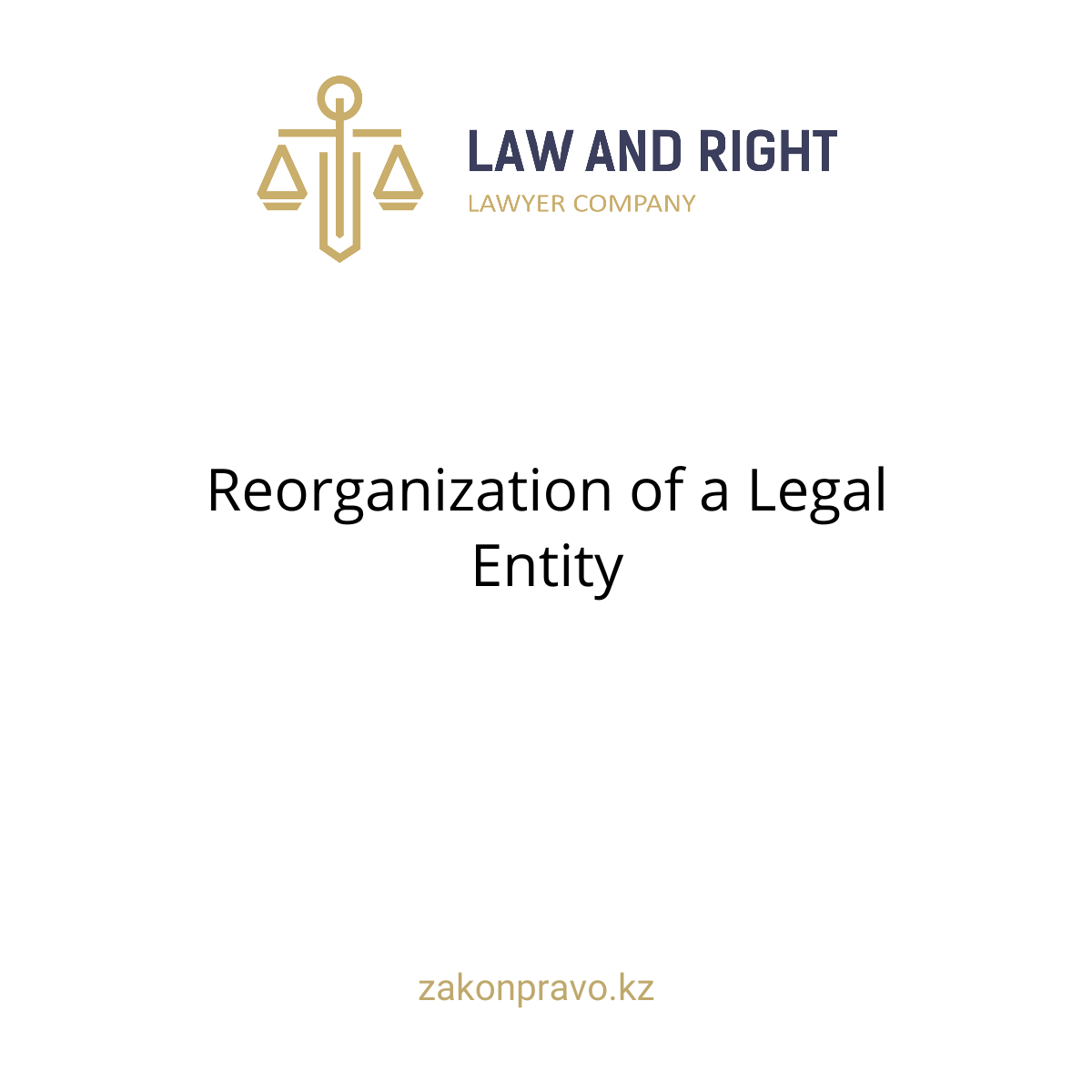Reorganization of a Legal Entity
🔷 I. General Overview
Reorganization is a legal process of transforming a legal entity, as a result of which:
- its structure and/or legal form changes;
- rights and obligations are transferred to other entities;
- a new entity may emerge or an existing one may cease to exist.
The Civil Code of the Republic of Kazakhstan (CC RK) recognizes five classical forms:
- merger,
- accession,
- division,
- separation,
- transformation.
Other forms are allowed if provided by special legislation (e.g., for joint-stock companies, financial institutions, etc.).
🧩 II. Forms of Reorganization (Classification)
| Form | Essence | Consequences |
|---|---|---|
| Merger | Combination of two or more legal entities into one new entity | All previous entities cease to exist, a new one is created |
| Accession | One legal entity joins another without terminating the latter | The joined entity ceases to exist |
| Division | One entity is split into several new ones | The original entity ceases to exist |
| Separation | A new entity is separated from the original one | The original continues to exist; rights and obligations are split via separation balance |
| Transformation | A change in the legal form of an entity | The subject remains the same, but its legal status changes |
📌 Example: If an LLP transforms into a JSC — this is transformation. If two LLPs create a new company — this is a merger.
⚖️ III. Grounds for Reorganization
1. Voluntary (para. 2)
- Decision of the property owner;
- Decision of the founders (participants);
- Decision of an authorized body;
- Basis — internal resolution.
2. Compulsory (para. 3)
- Only by court decision;
- In cases expressly provided by law (e.g., violations of antitrust law — see Law “On Competition,” Art. 59).
📌 The court appoints a manager who:
- prepares a separation balance;
- drafts founding documents;
- acts on behalf of the legal entity in court;
- organizes the registration of new entities.
🕓 IV. Moment of Reorganization (para. 4)
| Form | Moment of Completion |
|---|---|
| Merger, division, etc. | From the moment of state registration of new entities |
| Accession | From the moment an entry is made in the National BIN Register on the termination of the joined entity |
📌 This is crucial for tax, procedural, and labor consequences — from this moment, the new entity becomes the bearer of rights and obligations.
🔍 V. Sector-Specific Features
Certain entities are subject to reorganization only with regard to special requirements:
| Type of Organization | Regulatory Act |
|---|---|
| Joint-stock companies | Law “On Joint-Stock Companies” (Ch. 7) |
| Pension funds | Law “On Pension Provision” |
| Insurance and reinsurance companies | Law “On Insurance and Insurance Activity” |
| Financial and Islamic special companies | Law “On Project Financing and Securitization” |
| Microfinance and payment organizations | Laws “On Microfinance Activity,” “On Payment Systems” |
📚 VI. Case Law
📌 Example 1: AccessionCase No. 2-1154/2022, AlmatyCompany A was joined to Company B. The plaintiff filed a claim against Company A, unaware of the reorganization.The court dismissed the case, stating that Company B was the proper defendant, as it became the legal successor from the moment of BIN registration.
📌 Example 2: Compulsory DivisionAntitrust case, Astana, 2021The court satisfied the claim of the antitrust authority to divide a monopolist into two independent legal entities.Basis: violation of competition rules and abuse of dominant position (Art. 59, Law “On Competition”).
🔗 VII. Related Norms and Acts
| Source | Content |
|---|---|
| CC RK, Art. 46 | Succession in case of reorganization |
| CC RK, Art. 49 | Liquidation if reorganization is not applied |
| Law “On Registration of Legal Entities” | Procedure for registering newly created entities |
| Law “On Competition” | Possibility of compulsory reorganization |
| Tax Code of the RK | Procedure for transferring tax obligations during reorganization (Art. 56–59) |
| Law “On Bankruptcy” | Possibility of reorganization during rehabilitation |
| OECD, UNIDROIT | Recognize permissibility of compulsory reorganization to ensure competition and protect creditors’ rights |
✅ VIII. Practical Recommendations
- Before reorganization:
- Conduct legal and financial due diligence;
- Notify employees, creditors, and government agencies;
- Prepare a separation balance and founding documents.
- If you are a creditor:
- Check public BIN information;
- Monitor your counterparty's reorganization;
- If necessary — submit claims to the legal successor.
- In court-ordered reorganization:
- Cooperate with the appointed manager;
- Monitor court decisions and appeal if needed.
📘 IX. Conclusion
Article 45 of the Civil Code of the Republic of Kazakhstan provides a legal basis for all forms of voluntary and compulsory reorganization of legal entities. This provision aims to:
- ensure business flexibility;
- consolidate assets;
- reduce risks (through division);
- restore fair competition (through state intervention).
🔹 Legislation requires strict compliance with procedures for all types of reorganization, with mandatory registration and protection of third-party rights.
Attention!
Law and Law Law Law draws your attention to the fact that this document is basic and does not always meet the requirements of a particular situation. Our lawyers are ready to assist you in legal advice, drawing up any legal document suitable for your situation.
For more information, please contact a Lawyer / Attorney by phone: +7 (708) 971-78-58; +7 (700) 978 5755, +7 (700) 978 5085.
Attorney at Law Almaty Lawyer Legal Services Legal Advice Civil Criminal Administrative Cases Disputes Protection Arbitration Law Firm Kazakhstan Law Office Court Cases


